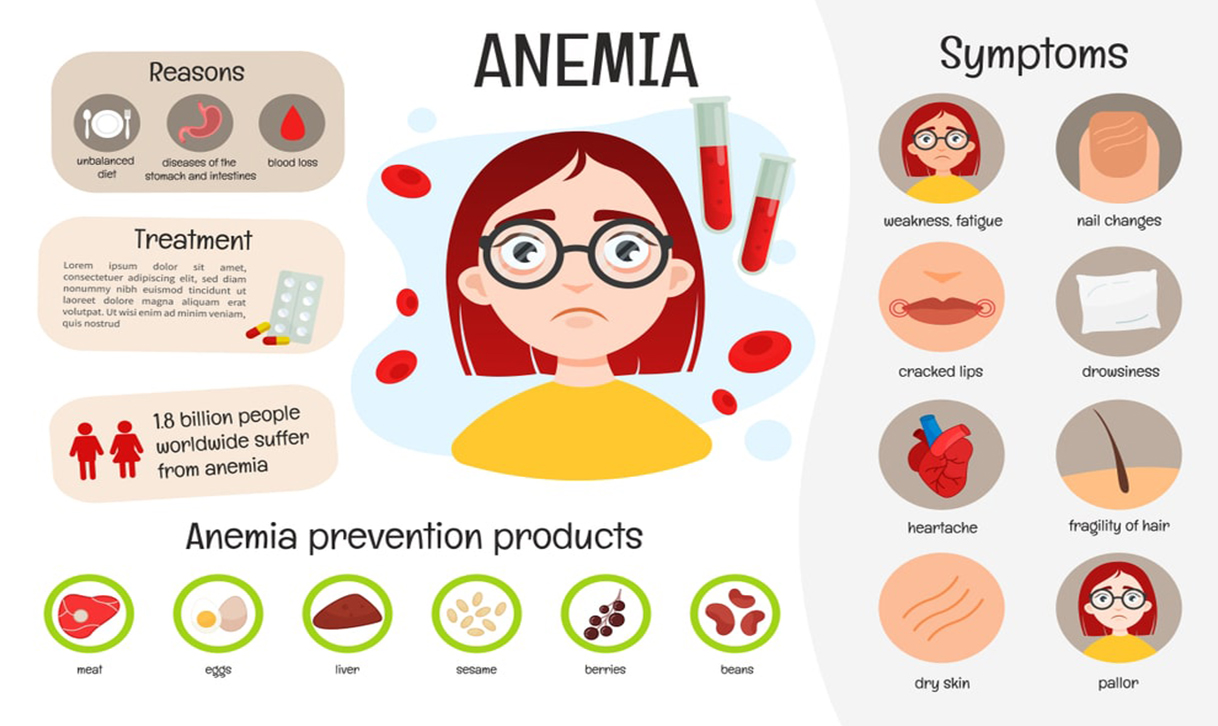ANEMIA
Anemia is a condition in which the body does not have enough healthy red blood cells. Red blood cells provide oxygen to body tissues. Different types of anemia include: Anemia due to vitamin B12 deficiency. Anemia due to folate (folic acid) deficiency.
The most common cause of anemia is not having enough iron. Your body needs iron to make hemoglobin. Hemoglobin is an iron-rich protein that gives the red color to blood. It carries oxygen from the lungs to the rest of the body
If the anemia gets worse, symptoms may include:
- Blue color to the whites of the eyes
- Brittle nails
- Desire to eat ice or other non-food things (pica syndrome)
- Lightheadedness when you stand up
- Pale skin color
- Shortness of breath with mild activity or even at rest
- Sore or inflamed tongue
- Mouth ulcers.
Anemia treatment depends on the cause
• Iron deficiency anemia Treatment for this form of anemia usually involves taking iron supplements and changing your diet. For some people, this might involve receiving iron through a vein
If the cause of iron deficiency is loss of blood — other than from menstruation — the source of the bleeding must be located and the bleeding stopped. This might involve surgery.
Vitamin deficiency anemias Treatment for folic acid and vitamin C deficiency involves dietary supplements and increasing these nutrients in your diet.
If your digestive system has trouble absorbing vitamin B-12 from the food you eat, you might need vitamin B-12 shots. At first, you might have the shots every other day. Eventually, you'll need shots just once a month, possibly for life, depending on your situation.
Anemia of chronic disease There's no specific treatment for this type of anemia. Doctors focus on treating the underlying disease. If symptoms become severe, a blood transfusion or injections of a synthetic hormone normally produced by your kidneys (erythropoietin) might help stimulate red blood cell production and ease fatigue.
Aplastic anemia Treatment for this anemia can include blood transfusions to boost levels of red blood cells. You might need a bone marrow transplant if your bone marrow can't make healthy blood cells
Anemias associated with bone marrow disease. Treatment of these various diseases can include medication, chemotherapy or bone marrow transplantation.
Hemolytic anemias Managing hemolytic anemias includes avoiding suspect medications, treating infections and taking drugs that suppress your immune system, which could be attacking your red blood cells. Severe hemolytic anemia generally needs ongoing treatment.
Sickle cell anemiaTreatment might include oxygen, pain relievers, and oral and intravenous fluids to reduce pain and prevent complications. Doctors might also recommend blood transfusions, folic acid supplements and antibiotics. A cancer drug called hydroxyurea (Droxia, Hydrea, Siklos) also is used to treat sickle cell anemia.
Thalassemia Most forms of thalassemia are mild and require no treatment. More-severe forms of thalassemia generally require blood transfusions, folic acid supplements, medication, removal of the spleen, or a blood and bone marrow stem cell transplant.
